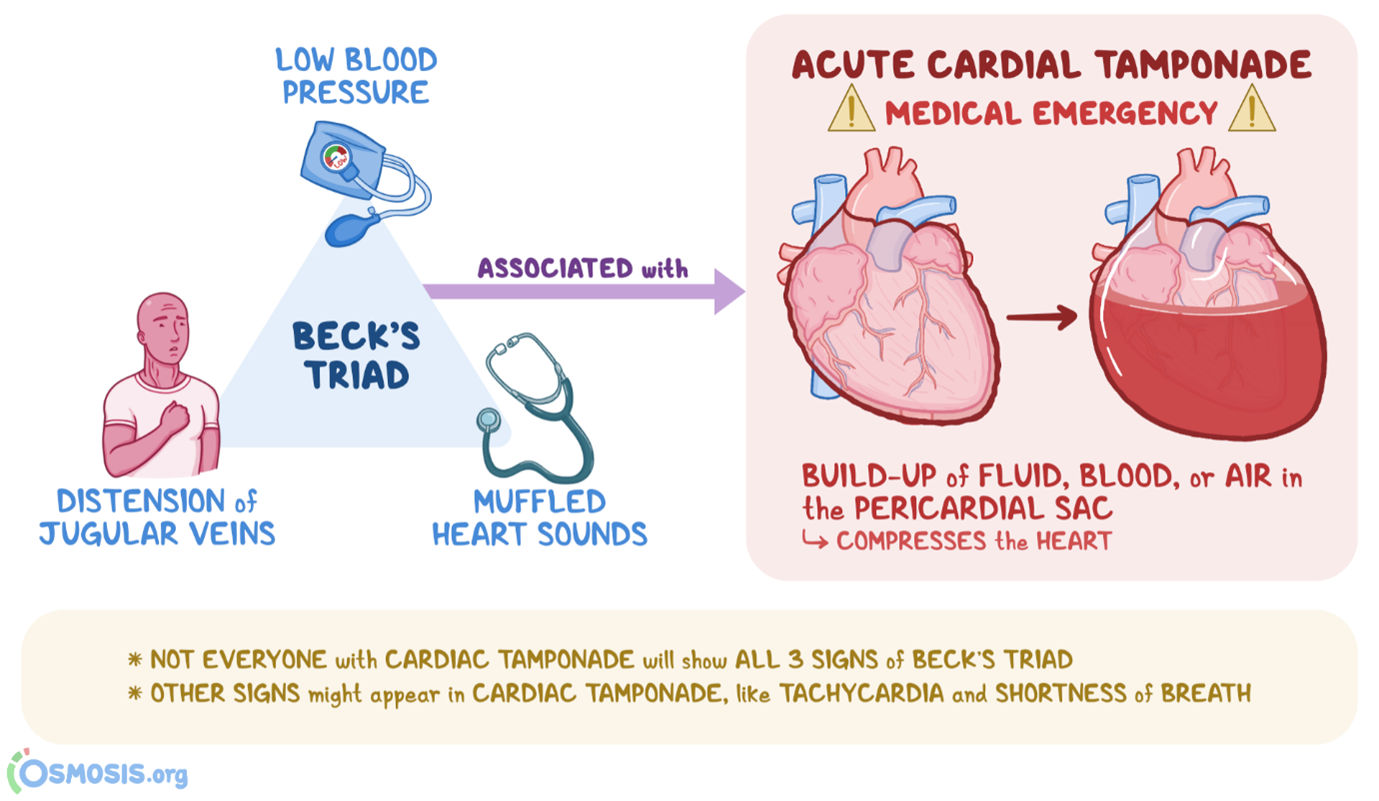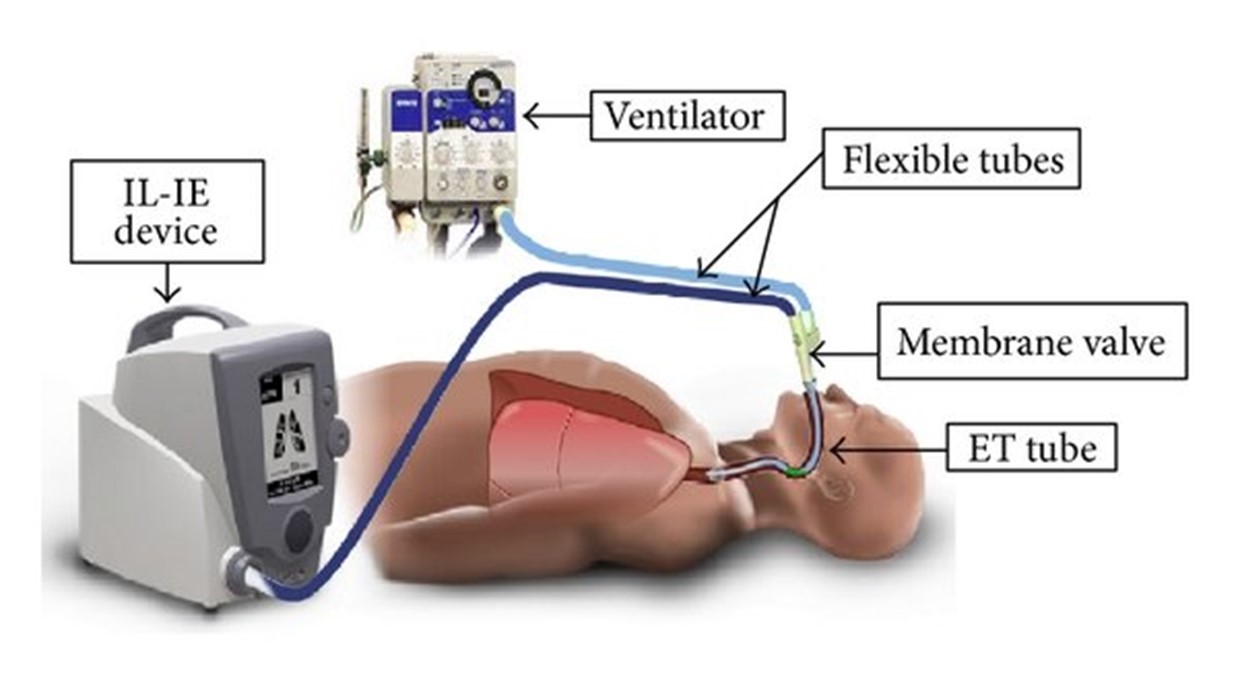Which of the following clinical manifestations is NOT considered part of Beck's triad (classic indications of cardiac tamponade)?
muffled heart tones
marked hypotension
distended jugular veins
widening pulse pressure
The Correct Answer is D
Beck's triad consists of three classic clinical manifestations that are suggestive of cardiac tamponade, which is the compression of the heart by accumulated fluid or blood within the pericardial sac. The three components of Beck's triad include:
A. Muffled heart tones in (option A) are incorrect because Cardiac tamponade can dampen or muffle heart sounds due to the presence of fluid or blood around the heart, which can impair sound transmission.
B. Marked hypotension in (option B) is incorrect because Cardiac tamponade can cause decreased cardiac output, leading to hypotension, which is characterized by low blood pressure.
C. Distended jugular veins in (option C) is incorrect because Elevated venous pressure resulting from impaired filling and elevated right-sided heart pressures can lead to jugular vein distension, which is commonly seen in cardiac tamponade.
However, widening pulse pressure (the difference between systolic and diastolic blood pressure) is not typically part of Beck's triad. Widening pulse pressure is associated with her conditions such as aortic regurgitation, hyperthyroidism, or conditions involving increased stroke volume, rather than cardiac tamponade specifically.

Nursing Test Bank
Naxlex Comprehensive Predictor Exams
Related Questions
Correct Answer is A
Explanation
The ABG results show a pH of 7.50, PaCO2 of 29 mmHg, and HCO3 of 23 mEq/L, indicating respiratory alkalosis. In respiratory alkalosis, there is a decrease in PaCO2 (hypocapnia), which can be caused by excessive ventilation.
To address the respiratory alkalosis, the nurse should decrease the respiratory rate. This would help reduce the amount of ventilation provided and allow the patient to retain more carbon dioxide (CO2), thereby increasing the PaCO2 levels and restoring acid-base balance.
B. Leaving the ventilator at the current settings in (option B) is incorrect because it may exacerbate respiratory alkalosis as it would maintain the same level of ventilation.
C. Increasing the tidal volume (VT) in (option C) is incorrect because it would not address the respiratory alkalosis. Tidal volume refers to the volume of air delivered with each breath, while the issue in this case is excessive ventilation leading to hypocapnia.
D. Increasing the FiO2 (fraction of inspired oxygen) in (option D) is incorrect because it is not indicated based on the given ABG results. The oxygenation (PaO2) level is within normal limits (80 mmHg), suggesting adequate oxygenation.
It is important to consult with the healthcare provider or respiratory therapist for further guidance on adjusting the ventilator settings based on the patient's condition and response to therapy.
Correct Answer is C
Explanation
In a patient receiving mechanical ventilation, a high respiratory rate can indicate increased work of breathing and potential airway obstruction. COPD patients, in particular, may have excessive mucus production and airway inflammation, leading to mucus plugging and compromised airway clearance. Suctioning may be necessary to remove excessive secretions and maintain a patent airway.
A. The pulse oximeter shows a SpO2 of 90% in (option A) is incorrect because While a SpO2 of 90% is suboptimal and may require intervention, it does not specifically indicate the need for suctioning. Other interventions, such as adjusting oxygen delivery or ventilation settings, may be more appropriate.
B. The patient has not been suctioned for the last 6 hours in (option B) is incorrect because The duration since the last suctioning episode alone does not necessarily indicate the need for suctioning. The need for suctioning should be based on the patient's clinical presentation, such as signs of airway obstruction or excessive secretions.
D. The lungs have occasional audible expiratory wheezes in (option D) which is incorrect because Occasional audible expiratory wheezes may be common in patients with COPD and may not specifically indicate the need for suctioning. Wheezing is more commonly associated with narrowing of the airways, and suctioning is typically performed to clear secretions or maintain airway patency.
C. Therefore, in a COPD patient receiving mechanical ventilation, a high respiratory rate (C) is the assessment information that would indicate the need for suctioning to help remove excessive secretions and ensure a patent airway

Whether you are a student looking to ace your exams or a practicing nurse seeking to enhance your expertise , our nursing education contents will empower you with the confidence and competence to make a difference in the lives of patients and become a respected leader in the healthcare field.
Visit Naxlex, invest in your future and unlock endless possibilities with our unparalleled nursing education contents today
Report Wrong Answer on the Current Question
Do you disagree with the answer? If yes, what is your expected answer? Explain.
Kindly be descriptive with the issue you are facing.
